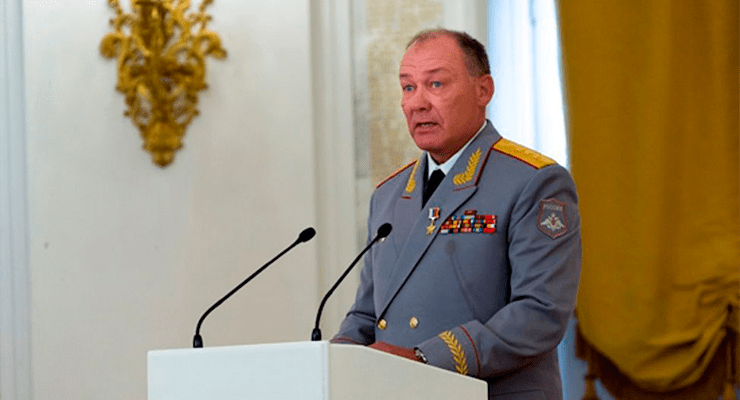
US and European officials believe that Russian President Vladimir Putin has appointed Gen. Aleksandr Dvornikov as the country’s ground commander in Ukraine in an apparent bid to iron out logistical challenges and centralise command over its campaign as Moscow prepares for a renewed assault in eastern Ukraine.
An experienced senior officer who oversaw Russia’s intervention in Syria, notorious for its brutal tactics, Dvornikov was widely seen as a potential successor to Gen. Valery Gerasimov, chief of the General Staff of the Russian Armed Forces. His appointment and Russia’s withdrawal from the Kyiv region, Ukraine’s capital, is tacit acknowledgement from Moscow that the invasion has not gone according to plan as Ukrainian and Western officials warn that a coming battle in the Donbas could eclipse the kind of fighting seen in the conflict thus far.
“The battle for Donbas will remind you of the Second World War, with its large operations, manoeuvre, involvement of thousands of tanks, armoured vehicles, planes, artillery,” Ukrainian Foreign Minister Dmytro Kuleba said following a meeting of NATO foreign ministers last week.
Dvornikov, who was commander of Russia’s Southern Military District, is believed to have been chosen in part because of Russian forces’ greater success in Ukraine’s south as opposed to the north, where efforts to take Kyiv were thwarted by fierce Ukrainian resistance, a senior US defence official, speaking on condition of anonymity, said on Monday.
“His forces have done relatively the least worst; let’s put it that way,” said Michael Kofman, an expert on the Russian military with CNA, a think tank. In the initial phase of the war, Russian forces attacked along three axes — from Crimea, from the Donbas and from the north — with little central coordination. As Western officials struggled to identify a single theatre commander, it was assumed much of the command and control of the operation was being run out of Moscow, a European official said, speaking on background on condition of anonymity.
“The creation of a theatre commander role like this is clearly intended to bring greater coordination to bear,” the official said. “We will see how effective that proves to be, as — frankly — the Russians have not really trained for that sort of fighting and it doesn’t really fit with their doctrine.”
Dvornikov was born in Ussuriysk in the Russian far east in 1961, and after graduating from the town’s military academy as a teenager he later attended the Frunze Military Academy in Moscow, one of the most prestigious military academies in the then-Soviet Union. As commander of a motor rifle regiment, he cut his teeth in the assault on Grozny, the capital of Chechnya, which began in 1999 and saw the city reduced to rubble.
After rising to become chief of staff of Russia’s Central Military District, Dvornikov was tapped as the first commander to oversee Putin’s military campaign in Syria in 2015, which is widely credited with helping turn the tide on the Syrian civil war in favour of the embattled regime of Syrian President Bashar al-Assad. In the initial phase of the operation, poor coordination between Russian air forces and pro-regime Syrian troops on the ground left Assad unable to conquer any rebel-held territory for months, until Dvornikov turned the campaign into a siege.
“The initial phase of the intervention was actually kind of unsuccessful. There was a very heavy sort of wave of airstrikes, but there was no territorial change for months,” said Charles Lister, a senior fellow and director of the Syria and countering terrorism and extremism programs at the Middle East Institute. “He had to adapt to a kind of old-fashioned style of warfare; a big, strong preference for standoff shelling [and] artillery. It was almost medieval in a way.”
His impact was also felt on command and control, as Dvornikov reshaped the beleaguered and demoralised Syrian forces backing Assad. He oversaw the relationship between Russian Spetsnaz units and Lebanese Hezbollah units that entered the war on Assad’s behalf, Lister said. Dvornikov cobbled together a mélange of units willing to fight for Assad, pairing Russian special operators with local units and mercenaries to devastating effect. Unlike the current top-down Russian campaign, Dvornikov favoured a high degree of manoeuvre “by autonomous groups of forces,” he wrote in a 2015 military journal article.
“He’s regarded as an effective commander but also quite an imaginative one,” said Mark Galeotti, a senior associate fellow with the Royal United Services Institute, a British think tank.
In Syria, Dvornikov oversaw a brutal campaign of airstrikes that included the flattening of Aleppo, the bombing of United Nations aid convoys and near-daily targeting of civilians in Idlib province with bombings of schools and hospitals. Dvornikov’s appointment is expected to coincide with an even more brutal phase of Russia’s military campaign in Ukraine, but that may have more to do with how Moscow wages war than with Dvornikov himself.
“It is how the Russians plan to fight these battles, rather than Dvornikov being some kind of sociopath,” Galeotti said.
But even as Russian forces regroup for an intense ground campaign to cut off Ukrainian troops in the Donbas, with some units relocating out of Ukraine to resupply and re-equip in western Russia and Belarus, current and former US and European officials do not expect Dvornikov’s appointment to immediately solve the command and logistical problems that have hamstrung the months-long invasion.
“The biggest challenge is taking a bunch of units, badly mauled in the fighting, [and] integrating this disparate force into an offensive that will include several operational directions of where they’re going to attack,” Kofman said. “And what layer of command they’ve established for them to do that right now is unclear.”
According to one Western intelligence estimate, nearly a quarter of Russian battalion tactical groups fighting in Ukraine have been rendered unable to fight in little more than a month of combat. Russia’s northern grouping of forces in and around Ukraine’s Donbas region includes 20 battalion tactical groups, slightly more than half of which are now in-country, the senior US defence official said on Monday.
“Our view is that even a changeover in personnel or leadership at the top is not going to erase the fact that this is a strategic failure for Russia,” White House Press Secretary Jen Psaki said in a press briefing on Monday.
US officials said the contours of that strategy are beginning to emerge with Russia’s ballistic missile attack on Friday against the railway hub of Kramatorsk, Ukraine, which killed 57 people on the Ukrainian-controlled side of the Donetsk region and where nearly several thousand people had gathered on train platforms to flee the region in expectation of intensified fighting in the coming days. On Monday, Ukrainian President Volodymyr Zelenskyy said Russia’s multi-week siege of the port city of Mariupol had killed “tens of thousands” of civilians who have been cut off from humanitarian aid for days.
“What is clear is that the Russians continue to sink to new lows of depravity and brutality,” the senior US defense official told reporters on Monday. “I think we’re certainly bracing ourselves here for some potentially really, really horrible outcomes.”
Experts think the increased Russian focus on the Donbas could also take hints from precedent, talking and fighting at once. In Syria, after Russia urged Assad’s forces to take back most of the country in a single, ultimately abortive, push, Dvornikov championed a divide-and-conquer approach that saw the Kremlin negotiate four de-escalation zones in the war-torn nation to freeze the conflict before helping the Syrians pick them off one at a time — often with chemical weapons. “It was a nationwide push and it catastrophically failed, and their adaptation was to create a kind of diplomatic geopolitical reality that allowed them to take one area at a time,” said Lister, the expert from the Middle East Institute.
And in Russia’s war in Ukraine, where putting civilians in harm’s way has not been an exception, Dvornikov could make it a norm, former US officials familiar with his brute force style said.
“He could make it very consistent that the targeting of civilians is not only acceptable, it’s actually promoted,” said Mick Mulroy, a former deputy assistant secretary of defence for the Middle East and a CIA paramilitary officer, in an interview. “[Putin] doesn’t need to go find another general who’s willing to sell his soul. This guy has already sold it.”









…. So who did “the dirty work” in Afghanistan – on the Russian side of course…… forget “ours” (and “Iraq”).
And who were the goodies that trained those “Taliban white-hats(?)” how to fight a “guerilla(?)” war against those Russian invaders back then…..
The Ukrainian government made quite a noise about how it was arming civilians with lots of TV images of just about everyone with a gun. In this type of war every civilian is suspect and front line troops of any nationality will shoot first before asking questions. So the next phase of the war will be very nasty indeed no matter who is in charge.
In the first weeks of Russia’s invasion, Ukrainian Women and Children were allowed to flee the conflict, but Males of fighting age – between 16 & 60, were not allowed to leave, and were “encouraged” to take up arms against Russian forces.
Hence it would seem there are a lot of “Civilians” actively participating in this war.
Secondly, the Azov Battalion, (part of Ukraine’s Military forces), have been known over the last 8 years during the fighting in the Donbas region, to embed themselves in civilian housing, shopping Centers, etc.
Both of the above points would suggest a lot of the current claims of Russia killing civilians is over exaggerated.
If a Civilian is carrying and operating weapons, and actively fighting in the War, are they still classified as a Civilian?
The difference is the theatre of war i.e. Russia invading or assisting Assad’s local forces in Syria is very different to having boots on the ground to fight fraternal sibling in European, sharing languages, culture and religion.
Another related issue, is how Russia seems to have firewalled Moscow/St. Petersburg or ‘western’ Russians from fighting in Ukraine with the losses being taken by regional inc. Caucasian, Eastern & Central Asian conscripts and related e.g. Kadyrov’s Chechens and mercenary Wagner Group (inc. neo Nazis).
how many times can you fit the word “brutal” in an article?
I’m not inclined to believe that all these sorts of pieces are propaganda, but at least try not to propagandize so much.